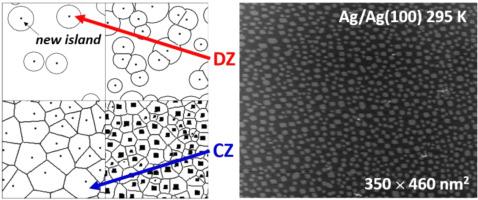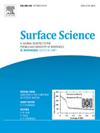外延支撑金属纳米团簇的形成与粗化
IF 2.1
4区 化学
Q3 CHEMISTRY, PHYSICAL
引用次数: 0
摘要
这篇微型综述介绍了过去 30 多年来在表征气相沉积过程中外延支撑金属纳米团簇(NC)或纳米岛的成核与amp; 生长及其沉积后粗化方面的发展。均匀成核& 生长的超均值场处理方法纠正了传统处理方法在描述(例如)纳米岛尺寸分布方面的不足,但也需要考虑纳米岛及其捕获区的空间分布。我们讨论了建模能力方面的进展,包括基于外围扩散动力学的非原位级处理,用于描述这些数控系统的非平衡生长形状,重点是二维数控系统。对于 NC 阵列的沉积后粗化,通常存在奥斯特瓦尔德熟化(OR)和斯莫卢霍斯基熟化(SR)之间的竞争。SR 也称为粒子迁移和凝聚。对于同向外延系统中的二维数控系统,在原始的 fcc(111) 表面上可以观察到传统的奥斯特瓦尔德衰变,而在 Cu(111) 和 Ag(111) 表面上,即使存在微量的查耳酮,奥斯特瓦尔德衰变也会显著增强,而在各向异性的 fcc(110) 表面上则会出现异常的奥斯特瓦尔德衰变。在 fcc(100) 同向共轴系统中意外发现的 SR,促使我们对二维 NC 的基本扩散性(作为尺寸函数)以及 NC 凝聚动力学进行了广泛分析。现在,我们已经对这些过程有了全面的了解。研究探讨了三维 NC 在沉积过程中的自组装、与异质成核、定向组装、NC 生长结构选择和粗化有关的问题。对于三维外延 NC 的 SR,介绍了对扩散性尺寸依赖性的最新见解。本文章由计算机程序翻译,如有差异,请以英文原文为准。

Formation and coarsening of epitaxially-supported metal nanoclusters
This mini-review describes developments over the last ∼30 years in characterizing the nucleation & growth of epitaxially-supported metal nanoclusters (NCs) or islands during vapor deposition, as well as their post-deposition coarsening. A beyond-mean-field treatment for homogeneous nucleation & growth corrects the deficiencies of traditional treatments in describing, e.g., the island size distribution, but also necessitates consideration of the spatial distribution of islands and their capture zones. We discuss advances in modeling capabilities, including those based upon on an ab-initio level treatment of periphery diffusion kinetics, for description of the non-equilibrium growth shapes of these NCs, focusing on 2D NCs. For post-deposition coarsening of arrays of NCs, there is generally a competition between Ostwald Ripening (OR) and Smoluchowski Ripening (SR). SR is also known as Particle Migration & Coalescence. For 2D NCs in homoepitaxial systems, conventional OR is observed on pristine fcc(111) surfaces, dramatically enhanced OR in the presence of even trace amounts of chalcogens for Cu(111) and Ag(111), and anomalous OR on anisotropic fcc(110) surfaces. The unexpected discovery of SR for fcc(100) homoepitaxial systems prompted extensive analysis of the underlying diffusivities of 2D NCs as a function of size, as well as of NC coalescence dynamics. A comprehensive understanding of these processes is now available. Self-assembly of 3D NCs during deposition, issues related to heterogeneous nucleation, directed assembly, NC growth structure selection, and coarsening are addressed. For SR of 3D epitaxial NCs, recent insights into the size-dependence of diffusivity are described.
求助全文
通过发布文献求助,成功后即可免费获取论文全文。
去求助
来源期刊

Surface Science
化学-物理:凝聚态物理
CiteScore
3.30
自引率
5.30%
发文量
137
审稿时长
25 days
期刊介绍:
Surface Science is devoted to elucidating the fundamental aspects of chemistry and physics occurring at a wide range of surfaces and interfaces and to disseminating this knowledge fast. The journal welcomes a broad spectrum of topics, including but not limited to:
• model systems (e.g. in Ultra High Vacuum) under well-controlled reactive conditions
• nanoscale science and engineering, including manipulation of matter at the atomic/molecular scale and assembly phenomena
• reactivity of surfaces as related to various applied areas including heterogeneous catalysis, chemistry at electrified interfaces, and semiconductors functionalization
• phenomena at interfaces relevant to energy storage and conversion, and fuels production and utilization
• surface reactivity for environmental protection and pollution remediation
• interactions at surfaces of soft matter, including polymers and biomaterials.
Both experimental and theoretical work, including modeling, is within the scope of the journal. Work published in Surface Science reaches a wide readership, from chemistry and physics to biology and materials science and engineering, providing an excellent forum for cross-fertilization of ideas and broad dissemination of scientific discoveries.
 求助内容:
求助内容: 应助结果提醒方式:
应助结果提醒方式:


